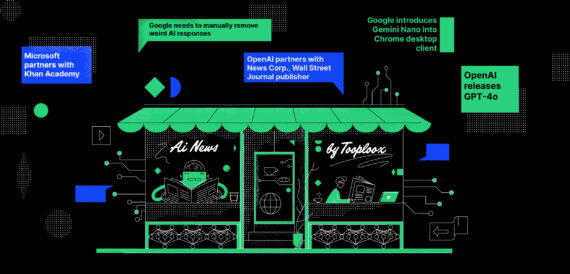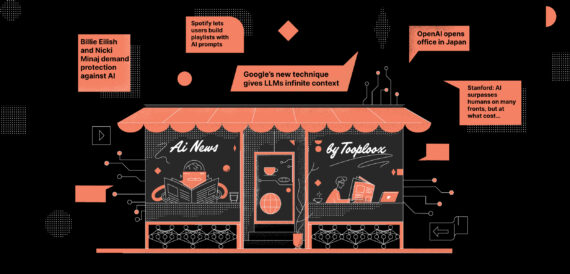From AI’s impact on the workforce to what share of the population uses Artificial Intelligence tools on the daily. From market valuations to concerns – this text is an intellectual roller coaster through the most important AI facts and statistics!
This text will cover statistics about AI as well as facts about artificial intelligence. All are curated and gathered to provide the reader with reliable knowledge. To make things easier, the text has been divided into sections (just click to slide directly to the desired section):
- Economic Impact and Industry Transformation
- Automation Potential
- AI Adoption and Market Valuation
- Public Perception and Regulatory Environment
- Future Projections and Predictions
- Research and Development in AI
- AI in Business and Operations
This collection of statistics about artificial intelligence also aims to show the direction in which the industry is evolving and the impact that new technology has on our world. The collection includes both generative AI statistics and traditional AI facts.
1. Economic Impact and Industry Transformation
This section shows the current state of AI in the context of the international economy. The way this new technology impacts markets and industries, how big savings it brings are, and how disruptive its power is. This section also shows AI industry growth regarding particular industries.
- Generative AI Economic Potential: $2.6 to $4.4 trillion annually across various industries (McKinsey)
- Generative AI could raise global GDP by 7% (Goldman Sachs)
Industry-Specific Productivity Lifts:
- Banking: $200 billion to $340 billion annually (McKinsey)
- Retail and Consumer Packaged Goods: $400 billion to $660 billion worldwide (McKinsey)
- Pharmaceuticals and Medical Products: $60 billion to $110 billion worldwide (McKinsey)
- AI in Retail: Market worth $6 billion, predicted to be worth $100 billion by 2032 (Global Market Insights)
- The global artificial intelligence (AI) in manufacturing market size reached USD 3.8 billion in 2022, and it is expected to hit around USD 68.36 billion by 2032 (Precedence Research)
Department-specific productivity lifts (McKinsey):
- Generative AI may drive a $404B productivity lift in Customer Operations worldwide
- Generative AI may drive a $464B productivity lift in Marketing worldwide
- Generative AI may drive a $486B productivity lift in Sales worldwide
- Generative AI may drive a $485B productivity lift in Corporate IT worldwide
- Generative AI may drive $414B productivity lift in Product Development worldwide
- Generative AI may drive a $382B productivity lift in Product RnD worldwide
AI Founding (Crunchbase)
- AI’s Share of US Startup Funding Doubled in 2023
- The funding of AI-related startups in 2018 accounted for an 11% share. In 2023, it was 26%.
2. Automation Potential
Handing the “dull and repetitive” tasks to AI has been a catchphrase since the first applications of the technology. This paragraph shows how promises have turned into Artificial Intelligence facts.
- Overall Automation Potential: Up to 70% of current work activities (McKinsey)
- 80% of US workforce may have at least 10% of their work tasks automated by GPT models (OpenAI)
- 19% of US workforce may have at least 50% of their work tasks automated by GPT models (OpenAI)
- about 15% of all worker tasks in the US could be completed significantly faster at the same level of quality when using GPT models. When incorporating software and tools built on top of LLMs, this share increases to between 47% and 56% of all tasks (OpenAI)
By Industry and Task (McKinsey):
- Office Support: 87%
- Production: 82%
- Food Services: 78%
- Mechanical Installation: 67%
- Community Services: 65%
- Customer Service: 57%
- Overall average across all industries: 63%
Impact on business strategy:
- On average, 50% of strategic planning and execution activities could be partially or fully automated by 2025; currently, only 15% are (Gartner)
- 20% of strategists reported using AI-related tools, such as machine learning or natural language processing (Gartner (2023))
- 79% of Corporate Strategists See AI and Analytics as Critical to their Success Over the Next Two Years (Gartner (2023))
3. AI Adoption and Market Valuation
The Artificial Intelligence stats shown in this section aim to show how much AI has grown since the introduction of the first basic techniques and, later on, the ChatGPT revolution. This segment provides a glimpse into current AI industry trends regarding market worth and Artificial Intelligence growth statistics.
Generative AI Investments and Market Dynamics:
- Global AI market: $196.63 billion in 2023(Grand View Research)
- US AI market: $42 billion in 2023 (Grand View Research)
- Generative AI funding: $25.2 billion in 2023 (2024 AI Index Report, Stanford Institute for Human-Centered Artificial Intelligence)
- 55% of Organizations are in Piloting or Production Mode with Generative AI (Gartner)
- 45% of enterprises are scaling generative AI investments across multiple business functions, with 22% scaling across more than three different functions (Gartner)
Generative AI Adoption Rates by Age Group in the US (Emarketer.com):
- 0-11 years: 3.4%
- 12-17 years: 11%
- 18-24 years: 14%
- 25-34 years: 21.4%
- 35-44 years: 19.3%
- 45-54 years: 13.3%
- 55-64 years: 11.2%
- 65+ years: 6.4%
AI adoption across industries (Statista):
- 37% of companies from the Marketing and Advertising industry have already adopted Generative AI
- 35% of companies from the Technology industry have already adopted Generative AI
- 30% of companies from the Consulting industry have already adopted Generative AI
- 19% of companies from the Teaching industry have already adopted Generative AI
- 16% of companies from the Accounting industry have already adopted Generative AI
- 15% of companies in the Healthcare industry have already adopted Generative AI
- Reaching its first million users took ChatGPT 5 days, compared to 2.5 months for Instagram, 5 months for Spotify, 10 months for Facebook, 2 years for Twitter, and 3.5 years for Netflix (Statista)
4. Public Perception and Regulatory Environment
As with every disruptive and world-transforming technology, AI needs to be regulated and overseen by the authorities. This section also covers societal facts about AI technology that need to be taken into account when thinking about the transformative potential of these tools.
Interaction with AI (Public Awareness of Artificial Intelligence in Everyday Activities – Pew Research Center):
- 27% of Americans say that they interact with AI at least several times a day
- 28% of Americans say that they interact with AI at least once a day or several times a week
- 44% of Americans say that they don’t regularly interact with AI
Concerns (Public Awareness of Artificial Intelligence in Everyday Activities – Pew Research Center)
- 15% of Americans say they are more excited than concerned about the impact that AI has on their lives
- 38% of Americans say they are more concerned than excited about the impact that AI has on their lives
- 46% of Americans show both excitement and concern about the impact of AI on their lives
General impact (2024 AI Index Report, Stanford Institute for Human-Centered Artificial Intelligence):
- 66% of Americans think AI will dramatically affect their lives in the next three to five years
- 52% of Americans express nervousness toward AI products and services
AI Regulations:
- Increase in the number of AI-related regulations in the US, growing by 56.3% last year to reach 25 total regulations (2024 AI Index Report, Stanford Institute for Human-Centered Artificial Intelligence)
- 85% of US adults support a nationwide effort across government, industry, and academia to make AI safe and secure (Mitre)
- 81% of US adults believe the industry should invest more in AI assurance (Mitre)
- 85% of US adults want the industry to transparently share AI assurance practices before bringing products equipped with AI technology to market (Mitre)
- 46% of US adults believe AI technologies are ready for use in mission-critical applications for defense and national security (Mitre)
5. Future Projections and Predictions
Along with multiple fun facts about AI, multiple concerns arise, including the impact of this new technology on the workforce and job market. Considering how many people use AI in their daily tasks, this impact is impossible to ignore and is only expected to grow.
Workforce Implications:
- Percentage of tasks automatable by AI:
- Over 80% of Fortune 500 companies have adopted ChatGPT within nine months of its launch (OpenAI)
- Shifts in workflows may expose jobs equivalent to 300 million full-time jobs globally (Goldman Sachs)
- 47% of Business Leaders Consider Using AI Over New Hires (Tech.co)
- AI skills on job market:
- 37% of companies using AI say the technology replaced workers in 2023 (ResumeBuilder)
- 96% of companies hiring in 2024 say candidates will benefit from having AI skills (ResumeBuilder)
- 44% of companies surveyed say AI will lead to layoffs in 2024 (ResumeBuilder)
- 83% say AI skills will help current employees retain their jobs (ResumeBuilder)
- 52% of employed US adult respondents are worried AI will replace them in their jobs (Mitre)
- 64% percent of US adults believe the primary purpose of AI is to assist, enhance, and empower consumers (Mitre)
- 85% of employment growth in the last 80 years was powered by the technology-driven creation of new positions (Goldman Sachs)
6. Research and Development in AI
Research and pushing the boundaries regarding human knowledge are among the coolest facts about AI. The AI stats below show model development and overall work on technological advances.
Advancements in AI Research (2024 AI Index Report, Stanford Institute for Human-Centered Artificial Intelligence):
- Notable AI models by region and collaboration: 61 notable models from the US, 21 from the EU, 15 from China
- Costs and funding of major AI models: OpenAI’s GPT-4, $78 million; Google’s Gemini Ultra, $191 million
- In 2023, the industry produced 51 notable machine-learning models, while academia contributed only 15
- There were also 21 notable models resulting from industry-academia collaborations in 2023, a new high
7. AI in Business and Operations
This section deals with AI Marketing Statistics, AI in HR and multiple other business-related facts about A.I.. It also features information on reducing costs with AI – or rather how AI and Machine learning has ALREADY done so.
Business Implementation of AI:
- 47% of companies invest in implementing generative AI in customer-facing functions (among which: (Gartner)
- 12% of companies invest in implementing generative AI in Sales
- 19% of companies invest in implementing generative AI in Marketing
- 16% of companies invest in implementing generative AI in Customer Service
- 30% of companies invest in implementing generative AI in IT functions (among which: (Gartner)
- 21% of companies invest in implementing generative AI in Coding
- 9% of companies invest in implementing generative AI in Infrastructure and Operations
- 4% of companies invest in implementing generative AI in HR
- 3% of companies invest in implementing generative AI in Legal
- 1% of companies invest in implementing generative AI in Finances
- 1% of companies invest in implementing generative AI in Procurement
- Generative AI may make knowledge workers between 30% and 40% more productive (PWC 2024 AI Business Predictions)
- 44% of business leaders are planning to implement data modernization efforts in 2024 (PWC 2024 AI Business Predictions)
- 54% of businesses have implemented some form of generative AI in their company in the year following the introduction of ChatGPT (PWC 2024 AI Business Predictions)
Generative AI-induced savings (Statista):
- As of February 2023, 1% of US companies saved 0 dollars
- As of February 2023, 9% of US companies saved between 1 and 5,000 dollars
- As of February 2023, 20% of US companies saved between 5,001 and 25,000 dollars
- As of February 2023, 22% of US companies saved between 25,001 and 50,000 dollars
- As of February 2023, 24% of US companies saved between 50,001 and 75,000 dollars
- As of February 2023, 14% of US companies saved between 75,001 and 100,000 dollars
- As of February 2023, 11% of US companies saved over 100,0000 dollars
Summary
The cool facts about AI given above give a solid foundation for the further analysis of AI business use cases and the impact of AI on society. This list will be updated regularly and kept clean to never fall out of date and serve everyone who’s looking for reliable and fact-checked information.






